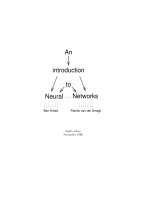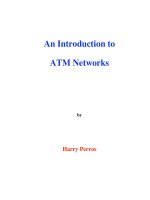ECE CS 372 introduction to computer networks lecture 1 chapter 5
Bạn đang xem bản rút gọn của tài liệu. Xem và tải ngay bản đầy đủ của tài liệu tại đây (1.14 MB, 32 trang )
Chapter 5: The Data Link Layer
Our goals:
Overview:
❒
❒
understand principles
behind data link layer
services:
❍
❍
❍
❍
❒
error detection,
correction
sharing a broadcast
channel: multiple access
link layer addressing
reliable data transfer,
flow control: done!
instantiation and
implementation of various
link layer technologies
❒
❒
❒
❒
link layer services
error detection, correction
multiple access protocols and
LANs
link layer addressing, ARP
specific link layer technologies:
❍
❍
❍
❍
❍
Ethernet
hibs, bridges, switches
IEEE 802.11 LANs
PPP
ATM
5: DataLink Layer
5a-1
Link Layer: setting the context
5: DataLink Layer
5a-2
Link Layer: setting the context
❒
two physically connected devices:
❍
❒
host-router, router-router, host-host
unit of data: frame
M
Ht M
Hn Ht M
Hl Hn Ht M
application
transport
network
link
physical
data link
protocol
phys. link
adapter card
network
link
physical
Hl Hn Ht M
frame
5: DataLink Layer
5a-3
Link Layer Services
❒
Framing, link access:
❍
❍
❍
❒
encapsulate datagram into frame, adding header, trailer
implement channel access if shared medium,
‘physical addresses’ used in frame headers to identify
source, dest
• different from IP address!
Reliable delivery between two physically connected
devices:
❍
❍
❍
we learned how to do this already (chapter 3)!
seldom used on low bit error link (fiber, some twisted pair)
wireless links: high error rates
• Q: why both link-level and end-end reliability?
5: DataLink Layer
5a-4
Link Layer Services (more)
Flow Control:
❍ pacing between sender and receivers
❒ Error Detection:
❍ errors caused by signal attenuation, noise.
❍ receiver detects presence of errors:
❒
• signals sender for retransmission or drops frame
❒
Error Correction:
❍ receiver identifies and corrects bit error(s)
without resorting to retransmission
5: DataLink Layer
5a-5
Link Layer: Implementation
❒
implemented in “adapter”
e.g., PCMCIA card, Ethernet card
❍ typically includes: RAM, DSP chips, host bus
interface, and link interface
❍
M
Ht M
Hn Ht M
Hl Hn Ht M
application
transport
network
link
physical
data link
protocol
phys. link
adapter card
network
link
physical
Hl Hn Ht M
frame
5: DataLink Layer
5a-6
Error Detection
EDC= Error Detection and Correction bits (redundancy)
D = Data protected by error checking, may include header fields
• Error detection not 100% reliable!
• protocol may miss some errors, but rarely
• larger EDC field yields better detection and correction
5: DataLink Layer
5a-7
Parity Checking
Single Bit Parity:
Detect single bit errors
Two Dimensional Bit Parity:
Detect and correct single bit errors
0
0
5: DataLink Layer
5a-8
Internet checksum
Goal: detect “errors” (e.g., flipped bits) in transmitted
segment (note: used at transport layer only)
Sender:
Receiver:
❒
❒
treat segment contents
as sequence of 16-bit
integers
❒ checksum: addition (1’s
complement sum) of
segment contents
❒ sender puts checksum
value into UDP checksum
field
compute checksum of
received segment
❒ check if computed checksum
equals checksum field value:
❍ NO - error detected
❍ YES - no error detected.
But maybe errors
nonethless? More later ….
5: DataLink Layer
5a-9
Checksumming: Cyclic Redundancy Check
view data bits, D, as a binary number
❒ choose r+1 bit pattern (generator), G
❒ goal: choose r CRC bits, R, such that
❒
❍
❍
❍
❒
<D,R> exactly divisible by G (modulo 2)
receiver knows G, divides <D,R> by G. If non-zero remainder:
error detected!
can detect all burst errors less than r+1 bits
widely used in practice (ATM, HDCL)
5: DataLink Layer 5a-10
CRC Example
Want:
D.2r XOR R = nG
equivalently:
D.2r = nG XOR R
equivalently:
if we divide D.2r by
G, want reminder R
D.2r
R = remainder[
]
G
5: DataLink Layer 5a-11
Multiple Access Links and Protocols
Three types of “links”:
point-to-point (single wire, e.g. PPP, SLIP)
❒ broadcast (shared wire or medium; e.g, Ethernet,
Wavelan, etc.)
❒
❒
switched (e.g., switched Ethernet, ATM etc)
5: DataLink Layer 5a-12
Multiple Access protocols
single shared communication channel
❒ two or more simultaneous transmissions by nodes:
interference
❒
❍
❒
only one node can send successfully at a time
multiple access protocol:
❍
❍
❍
distributed algorithm that determines how stations share channel,
i.e., determine when station can transmit
communication about channel sharing must use channel itself!
what to look for in multiple access protocols:
• synchronous or asynchronous
• information needed about other stations
• robustness (e.g., to channel errors)
• performance
5: DataLink Layer 5a-13
Multiple Access protocols
❒
claim: humans use multiple access protocols all the time
❒
class can "guess" multiple access protocols
multiaccess
❍ multiaccess
❍ multiaccess
❍ multiaccess
❍
protocol
protocol
protocol
protocol
1:
2:
3:
4:
5: DataLink Layer 5a-14
MAC Protocols: a taxonomy
Three broad classes:
❒ Channel Partitioning
❍
❍
divide channel into smaller “pieces” (time slots,
frequency)
allocate piece to node for exclusive use
Random Access
❍ allow collisions
❍ “recover” from collisions
❒ “Taking turns”
❒
❍
tightly coordinate shared access to avoid collisions
Goal: efficient, fair, simple, decentralized
5: DataLink Layer 5a-15
Channel Partitioning MAC protocols: TDMA
TDMA: time division multiple access
access to channel in "rounds"
❒ each station gets fixed length slot (length = pkt trans time) in each round
❒ unused slots go idle
❒ example: 6-station LAN, 1,3,4 have pkt, slots 2,5,6 idle
❒
❒
TDM (Time Division Multiplexing): channel divided into N time slots, one per user;
inefficient with low duty cycle users and at light load.
❒
FDM (Frequency Division Multiplexing): frequency subdivided.
5: DataLink Layer 5a-16
Channel Partitioning MAC protocols: FDMA
FDMA: frequency division multiple access
channel spectrum divided into frequency bands
❒ each station assigned fixed frequency band
❒ unused transmission time in frequency bands go idle
❒ example: 6-station LAN, 1,3,4 have pkt, frequency bands 2,5,6 idle
frequency bands
❒
time
❒
TDM (Time Division Multiplexing): channel divided into N time slots, one per user;
inefficient with low duty cycle users and at light load.
❒
FDM (Frequency Division Multiplexing): frequency subdivided.
5: DataLink Layer 5a-17
Channel Partitioning (CDMA)
CDMA (Code Division Multiple Access)
❒
❒
❒
❒
❒
❒
unique “code” assigned to each user; ie, code set partitioning
used mostly in wireless broadcast channels (cellular,
satellite,etc)
all users share same frequency, but each user has own
“chipping” sequence (ie, code) to encode data
encoded signal = (original data) X (chipping sequence)
decoding: inner-product of encoded signal and chipping
sequence
allows multiple users to “coexist” and transmit
simultaneously with minimal interference (if codes are
“orthogonal”)
5: DataLink Layer 5a-18
CDMA Encode/Decode
5: DataLink Layer 5a-19
CDMA: two-sender interference
5: DataLink Layer 5a-20
Random Access protocols
❒
When node has packet to send
❍
❍
transmit at full channel data rate R.
no a priori coordination among nodes
two or more trasnmitting nodes -> “collision”,
❒ random access MAC protocol specifies:
❒
❍
❍
❒
how to detect collisions
how to recover from collisions (e.g., via delayed
retransmissions)
Examples of random access MAC protocols:
❍
❍
❍
slotted ALOHA
ALOHA
CSMA and CSMA/CD
5: DataLink Layer 5a-21
Slotted Aloha
time is divided into equal size slots (= pkt trans. time)
❒ node with new arriving pkt: transmit at beginning of
next slot
❒ if collision: retransmit pkt in future slots with
probability p, until successful.
❒
Success (S), Collision (C), Empty (E) slots
5: DataLink Layer 5a-22
Slotted Aloha efficiency
Q: what is max fraction slots successful?
A: Suppose N stations have packets to send
❍ each transmits in slot with probability p
❍ prob. successful transmission S is:
by single node:
S= p (1-p)(N-1)
by any of N nodes
S = Prob (only one transmits)
= N p (1-p)(N-1)
… choosing optimum p as n -> infty ...
= 1/e = .37 as N -> infty
At best: channel
use for useful
transmissions 37%
of time!
5: DataLink Layer 5a-23
Pure (unslotted) ALOHA
unslotted Aloha: simpler, no synchronization
❒ pkt needs transmission:
❒
❍
❒
send without awaiting for beginning of slot
collision probability increases:
❍
pkt sent at t0 collide with other pkts sent in [t0-1, t0+1]
5: DataLink Layer 5a-24
Pure Aloha (cont.)
P(success by given node) = P(node transmits)
.
P(no other node transmits in [p0-1,p0] .
P(no other node transmits in [p0-1,p0]
= p . (1-p) . (1-p)
P(success by any of N nodes) = N p . (1-p) . (1-p)
S = throughput = “goodput”
(success rate)
… choosing optimum p as n -> infty ...
= 1/(2e) = .18
0.4
0.3
Slotted Aloha
0.2
0.1
protocol constrains
effective channel
throughput!
Pure Aloha
0.5
1.0
1.5
2.0
G = offered load = Np
5: DataLink Layer 5a-25









